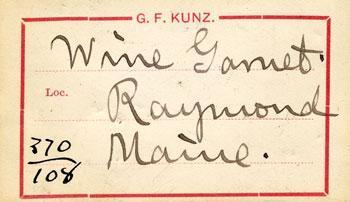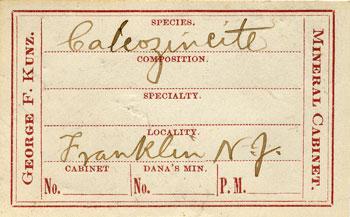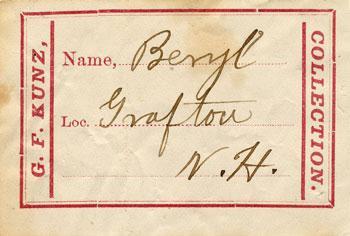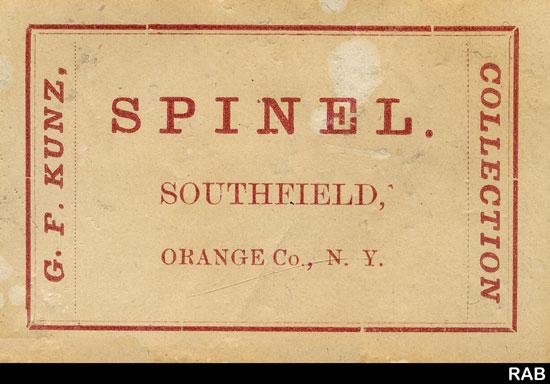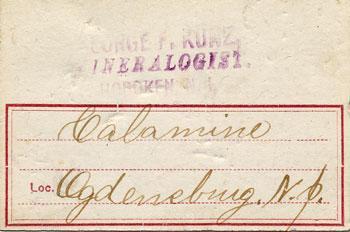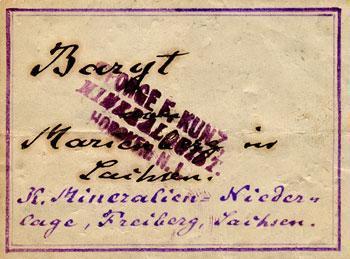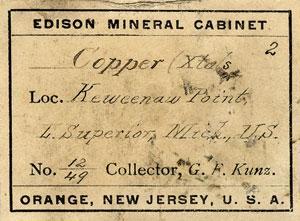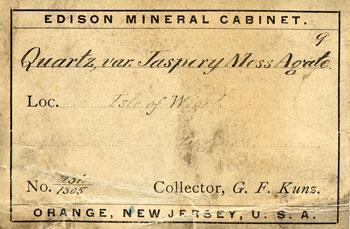Kunz, George F. (1856-1932 )
George Frederick Kunz, one of America's most prominent early gem experts, was born in New York City on September 29, 1856, the son of immigrant parents J.G. Kunz (who was German) and Marie Ida Widmar (who was Swiss). He spent his youth in Hoboken, New Jersey, where he got interested in collecting zeolites and other minerals in the traprocks of the Palisades and the Watchung Mountains. He is said to have begun exchanging specimens with European collectors at the age of 14. When he was 20 he built up a mineral collection of about 4,000 carefully labeled specimens which he sold for $400 to the University of Minnesota. This was the first of numerous important collections which he assembled throughout his life and sold to institutions, including a research collection assembled for Thomas Edison, and the famous Morgan-Tiffany collection of gems which went to the American Museum of Natural History. He was also instrumental in the purchase of the Bement mineral collection for the American Museum by J.P. Morgan..Kunz was educated in the public schools and received more advanced training at Cooper Union, but he was largely self-taught in mineralogy and gemology, an expertise which got him a position as gem expert with Tiffany & Company when he was 23. He stayed with the company for 53 years, rising to the position of Vice President, in recognition of his success in finding gem sources for the jewelry made by Tiffany. He also became a prolific author of joirnal articles and reports (about 500) and important books on gemstones, such as Gems and Precious Stones of North America (1890) and The Curious Lore of Precious Stones (1913). He was one of the founders of the New York Mineralogical Club and served as its President, was a Secretary of American Society of Arts and Science, and Corresponding Secretary of the Philadelphia Academy of Sciences, as well as holding positions in numerous other societies. He was made Honorary Curator of Precious Stones at the American Museum of Natural History, and was a Curator for the New York Academy of Sciences. In light of his scholarly achievements he eventually received honorary degrees from several institutions including Columbia University (M.A., 1898), the University of Marburg (PhD, 1903) and Knox University (D.Sc., 1907).
Kunz was placed in charge of the mining department at the Paris Exposition of 1889, the Kimberley, South Africa Exposition of 1892, and the Chicago Exposition of 1893. He was also appointed an "honorary special agent" of the mining departments of the Atlanta Exposition of 1895, the Omaha Exposition of 1898, and the Paris Expoisition of 1900. He was awarded the Legion of Honor in France, was made a Knight of the Order of St. Olaf in Norway, and was made an officer of the Rising Sun in Japan. He served as special agent for the U.S. Geological Survey from 1883-1909, producing annual reports on precious stone production in the U.S. until his death. In 1903 the pink gem variety of spodumene was named kunzite in his honor. He died in New York on June 29, 1932.
Click to images to view larger
To contribute more information please E-mail us at:
minrecord@comcast.net
Citation format for this entry:
WILSON, Wendell E. 2022
Mineralogical Record
Biographical Archive, at www.mineralogicalrecord.com
minrecord@comcast.net
Citation format for this entry:
WILSON, Wendell E. 2022
Mineralogical Record
Biographical Archive, at www.mineralogicalrecord.com

